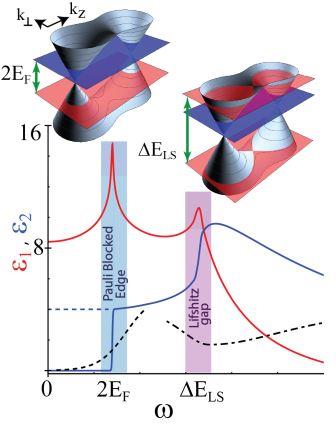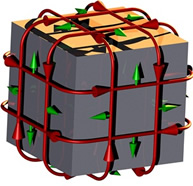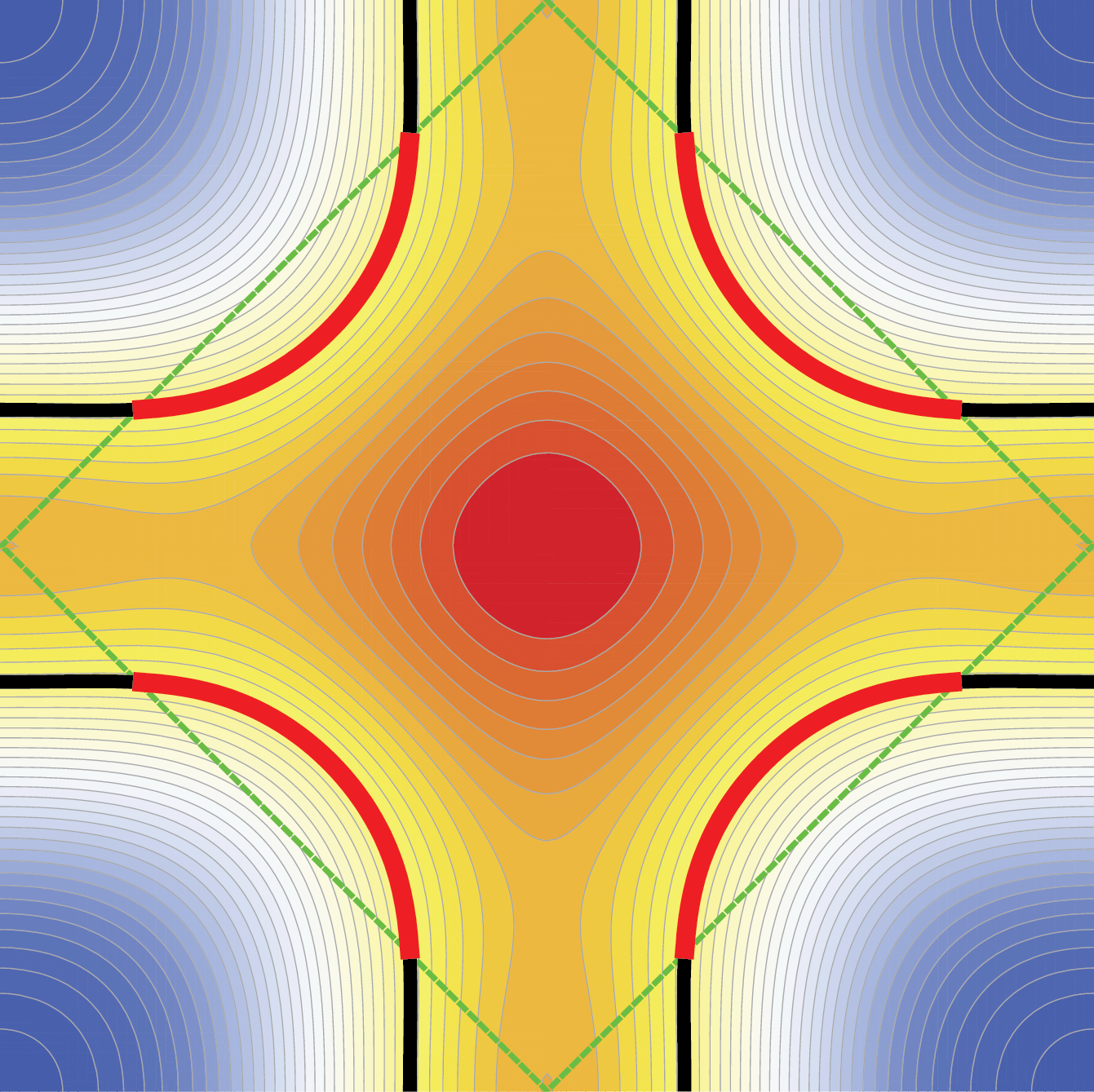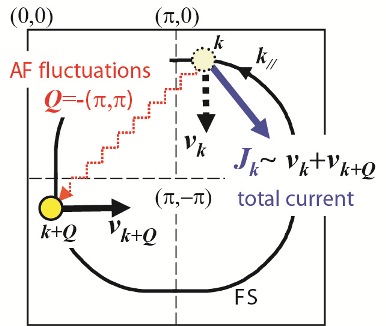
Menu:
Research
Weyl and 3D Dirac semimetals
 In condensed-matter systems, Dirac fermions exist in the valence and conduction bands that touch at a pair of points and disperse linearly away from the nodes. These bands are protected against gapping by crystal symmetry. If either crystal inversion or time-reversal symmetry is broken, each Dirac node splits into a pair of opposite chirality Weyl nodes, topological objects that act as a source or sink of Berry's phase curvature. This topological band structure effect is analogous to opposite-polarity magnetic monopoles residing at the nodes in momentum space, which fundamentally alter the semiclassical equations of motion and Maxwell's constitutive relations. The repercussions include new unique electronic properties like Fermi-arc surface states, chiral pumping effects, and magnetoelectric-like effects in plasmonics and optics in the absence of an applied field.
In condensed-matter systems, Dirac fermions exist in the valence and conduction bands that touch at a pair of points and disperse linearly away from the nodes. These bands are protected against gapping by crystal symmetry. If either crystal inversion or time-reversal symmetry is broken, each Dirac node splits into a pair of opposite chirality Weyl nodes, topological objects that act as a source or sink of Berry's phase curvature. This topological band structure effect is analogous to opposite-polarity magnetic monopoles residing at the nodes in momentum space, which fundamentally alter the semiclassical equations of motion and Maxwell's constitutive relations. The repercussions include new unique electronic properties like Fermi-arc surface states, chiral pumping effects, and magnetoelectric-like effects in plasmonics and optics in the absence of an applied field.
Optical measurements have been reported on the 3D Dirac semimetals Na3Bi and Cd3As2, and the time-symmetry broken Weyl material Eu2Ir2O7. In all systems, signatures of the Dirac dispersion are encoded in optical data through the temperature dependent chemical potential affecting the Drude free carrier response and interband transitions. The effects allow extraction of the Fermi velocity, anisotropy, Lifshitz gap characteristics, intrinsic doping level, and interaction energy. Current work focuses more on directly probing the underlying Berry-phase curvature employing magneto-optical measurement schemes.
In the pyrochlore Eu2Ir2O7, the onset of semimetallic behavior below the magnetic transition temperature and Dirac-like behavior of conductivity at low frequency provides optical evidence that Eu2Ir2O7 (at a specific off-stoichiometry) is a Weyl state system. Since Na3Bi is highly reactive with air, performing measurements is sufficiently challenging that this was the first reported optical characterization. A few discoveries were made: a bulk mode exists near the plasma edge that may indicate unexpected Weyl state magneto-plasmon effects, the ground state crystal symmetry is likely P3c1, the optical matrix elements are zero at the Lifshitz (saddle point) gap at the G-point, and a non-monotonic strongly temperature dependent plasma edge is indicative of the temperature dependence of Dirac free carriers.
1. G. S. Jenkins, C. Lane, B. Barbiellini, A. B. Sushkov, el al., “Three-dimensional Dirac cone carrier dynamics in Na3Bi and Cd3As2,” Phys. Rev. B 94, 85121 (2016). http://dx.doi.org/10.1103/PhysRevB.94.085121
2. A. B. Sushkov, J. B. Hofmann, G. S. Jenkins, et al, “Optical evidence for a Weyl semimetal state in pyrochlore Eu2Ir2O7,” Phys. Rev. B 92, 241108 (2015). http://dx.doi.org/10.1103/PhysRevB.92.241108
Topological Insulators
 Three dimensional topological insulators have two-dimensional surface states that exhibit Dirac-like dispersion similar to graphene, but the spins of the electrons are locked perpendicularly to the surface current. Manipulating the current (electric field) effects the spins (magnetic field) and vice versa. This and other emergent exotic properties, with the introduction of magnetically or superconducting induced energy gaps in the surface state, may have far reaching implications ranging from quantum computing to spintronics. The properties of the surface state in the topological insulator Bi2Se3 were spectroscopically characterized at terahertz frequencies in magnetic field. A Dirac-like cyclotron mass and evidence of puddling in the vicinity of the Dirac point was observed similar to graphene. When buried beneath the trivial insulator In2Se3, the surface state shows evidence of a large shift of the Dirac point towards the conduction band edge. This shift of the Dirac point is tunable through the material properties of the trivial insulator offering new routes to tailoring the surface.
Three dimensional topological insulators have two-dimensional surface states that exhibit Dirac-like dispersion similar to graphene, but the spins of the electrons are locked perpendicularly to the surface current. Manipulating the current (electric field) effects the spins (magnetic field) and vice versa. This and other emergent exotic properties, with the introduction of magnetically or superconducting induced energy gaps in the surface state, may have far reaching implications ranging from quantum computing to spintronics. The properties of the surface state in the topological insulator Bi2Se3 were spectroscopically characterized at terahertz frequencies in magnetic field. A Dirac-like cyclotron mass and evidence of puddling in the vicinity of the Dirac point was observed similar to graphene. When buried beneath the trivial insulator In2Se3, the surface state shows evidence of a large shift of the Dirac point towards the conduction band edge. This shift of the Dirac point is tunable through the material properties of the trivial insulator offering new routes to tailoring the surface.
1. G. S. Jenkins et al, “Giant plateau in the terahertz Faraday angle in gated Bi2Se3,” Phys. Rev. B 86, 235133 (2012). http://dx.doi.org/10.1103/PhysRevB.86.235133
2. G. S. Jenkins et al, “High mobility topological interface state probed by terahertz measurements,” arXiv:1208.3881 (2012). http://arxiv.org/abs/1208.3881
Graphene And Carbon Nanotube Emitters & Detectors
 I am an active collaborator in research into the use of graphene and carbon nanotubes as detectors in the THz and IR spectral region. Graphene is particularly well suited for use as a bolometer — a device that detects temperature-induced changes in electrical conductivity caused by the absorption of light— since it has a small electron heat capacity and weak electron–phonon coupling. The combined effects lead to large light-induced changes of the electron temperature.
I am an active collaborator in research into the use of graphene and carbon nanotubes as detectors in the THz and IR spectral region. Graphene is particularly well suited for use as a bolometer — a device that detects temperature-induced changes in electrical conductivity caused by the absorption of light— since it has a small electron heat capacity and weak electron–phonon coupling. The combined effects lead to large light-induced changes of the electron temperature.
Compared with commercial state-of-the-art semiconducting bolometer detectors, a hot-electron bolometer made of bilayer graphene demonstrated a noise-equivalent power that is several times lower with an intrinsic speed (>1 GHz at 10 K) three to five orders of magnitude higher.
Single carbon nanotube quantum dots coupled to antennas are sensitive, broadband, terahertz quantum detectors with spectral resolution. Their response is due to photon-assisted single-electron tunneling and it is substantially enhanced by a novel radiation-induced non-equilibrium cooling of the electrons.
In single layer graphene, an important avenue of exploration involves asymmetric coupling of contacts to the graphene while leveraging the strong photothermoelectric effect. Coupling antennas to graphene structures permits the investigation of plasmonic detection schemes. Current research focuses on multimode mixing in novel single layer plasmonic detectors.
1. D. Schmadel, G. S. Jenkins, and H. D. Drew, “Proposal for a Graphene Plasmonic THz Emitter,” arXiv:1311.1605 [cond-mat] (2013). http://arxiv.org/abs/1311.1605
2. X. Cai, A. B. Sushkov, R. J. Suess, M. M. Jadidi, G. S. Jenkins, L. O. Nyakiti, R. L. Myers-Ward, S. Li, J. Yan, D. K. Gaskill, T. E. Murphy, H. D. Drew, and M. S. Fuhrer, “Sensitive room-temperature terahertz detection via the photothermoelectric effect in graphene,” Nat Nano advance online publication, (2014). http://dx.doi.org/10.1038/nnano.2014.182
3. J. Yan, M.-H. Kim, J. A. Elle, A. B. Sushkov, G. S. Jenkins, H. M. Milchberg, M. S. Fuhrer, and H. D. Drew, “Dual-gated bilayer graphene hot-electron bolometer,” Nature Nanotechnology 7, 472–478 (2012). http://dx.doi.org/10.1038/nnano.2012.88
4. M. Rinzan, G. S. Jenkins, H. D. Drew, S. Shafranjuk, and P. Barbara, “Carbon Nanotube Quantum Dots As Highly Sensitive Terahertz-Cooled Spectrometers,” Nano Lett. 12, 3097–3100 (2012). http://dx.doi.org/10.1021/nl300975h
High Temperature Cuprate Superconductors
 Since their discovery 25 years ago, the anomalous Hall effect in the cuprates has played a central roll in providing vital clues to the possible mechanisms which describe the electronic properties. By extending the dc Hall measurements to finite frequency, crucial information has been garnered to help solve this long standing problem. The anomalous magneto-transport properties in both n- and p-type cuprates were investigated using Hall measurements at THz frequencies. In overdoped
Since their discovery 25 years ago, the anomalous Hall effect in the cuprates has played a central roll in providing vital clues to the possible mechanisms which describe the electronic properties. By extending the dc Hall measurements to finite frequency, crucial information has been garnered to help solve this long standing problem. The anomalous magneto-transport properties in both n- and p-type cuprates were investigated using Hall measurements at THz frequencies. In overdoped
In underdoped
 In optimally doped
In optimally doped
The anomalous behavior of the Hall effect, at dc as well as at THz frequencies in both n- and p-type cuprates, appears to be captured by the same physics. Current work is now focused upon the underdoped region in p-type cuprates where antiferromagnetic fluctuations are expected to play a diminishing roll in the Hall phenomenology as doping decreases.
1. G. S. Jenkins et al, “Terahertz magnetotransport measurements in underdoped Pr2-xCex CuO4 and comparison with angle-resolved photoemission,” Phys. Rev. B 79, 224525 (2009). http://dx.doi.org/10.1103/PhysRevB.79.224525
2. G. S. Jenkins et al, “Terahertz Hall measurements on optimally doped single-crystal Bi2Sr2 CaCu2 O8+x,” Phys. Rev. B 82, 094518 (2010). http://dx.doi.org/10.1103/PhysRevB.82.094518
3. Origin of the anomalous Hall effect in the overdoped n -type superconductor Pr2-xCexCuO4: Current-vertex corrections due to antiferromagnetic fluctuations,” Phys. Rev. B 81, 024508 (2010). http://dx.doi.org/10.1103/PhysRevB.81.024508
Berry-phase Contribution To Photocurrents In GaAs Quantum Well Stacks
Currently, no experimental evidence has been associated with an expected Berry-phase contribution to transport properties in which time reversal symmetry is preserved and inversion symmetry is broken. A recent prediction shows the helicity-dependent photocurrents in zincblende semiconducting quantum wells are controlled by a Berry-phase contribution generated by quantum confinement. A polarization-sensitive photocurrent measurement system utilizing a novel polarization modulation technique to test these predictions in a GaAs (110) quantum well stack has been implemented.
1. J. E. Moore and J. Orenstein, “Confinement-induced Berry phase and helicity-dependent photocurrents,” 0911.3630 (2009). http://arxiv.org/abs/0911.3630